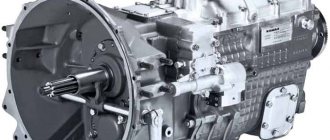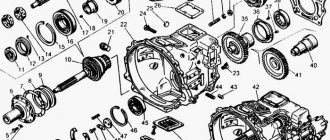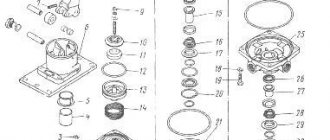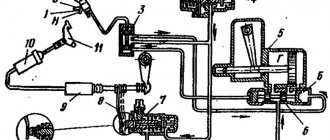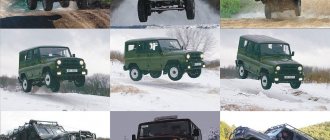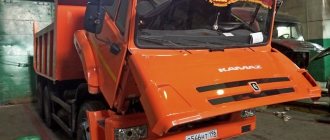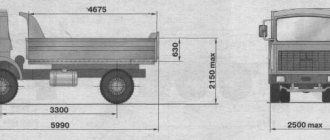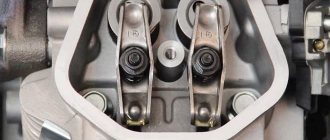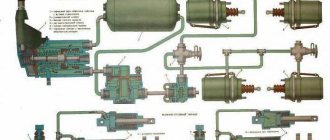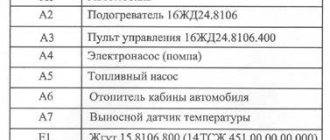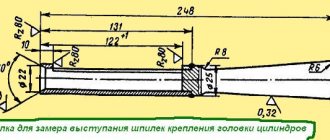Gearbox model ZF-16S151
The transmission of the ZF-16S151 model is a sixteen-speed manual, consisting of a four-speed main gearbox with a built-in two-stage divider located in front of the main box, and a two-stage planetary gearbox located behind the main box.
Rice. 3-66. Connection diagram for pneumatic control for the divider and multiplier: 1 - clutch reservoir; 2 — clutch pedal; 3 — gear shift lever; 4 — reverse sensor; 5 — valve for switching on the range multiplier; 6 — neutral sensor; 7 — sensor for switching on the low range of the range multiplier; 8 — range switching cylinder; 9 — first gear sensor; 10 — air distributor of the divider; 1 1 — sensor for switching on the low range of the divider; 12 — top gear engagement sensor; 13 - to the clutch slave cylinder; 14 — valve for switching on the divider; 15 — clutch master cylinder.
The gearbox consists of the following main components: a main four-stage gearbox, a front two-stage gear divider and a range-shifter. All forward gears in the main gearbox are activated by synchronizers, and the reverse gear is engaged by a gear clutch. The multiplier is planetary and is automatically switched using a pneumatic valve using a clutch synchronizer when the lever is moved.
Mechanical sixteen-speed, consisting of a main four-stage gearbox, a front two-stage gear divider and a multiplier
Max. input torque, N.m
L—lowest gear in the divider; S—highest gear in the divider; R - reverse
Roller needles with cages without rings
Inertial type, coupling with steel friction rings coated with molybdenum
With helical teeth, constant mesh
Non-contact, 6-prong inductor
All parts are splash lubricated; the bearings of the gearbox, divider and range gears also have additional feed from the oil pump
Behind the end of the main gearbox intermediate shaft
Gearbox control
Mechanical, with remote drive for the main gearbox (an option with a servo amplifier is possible), pneumatic preselector for the divider, pneumatic for the range-multiplier
Force on the gear shift lever, N (kgf), no more
Gearbox control
Gears are changed using a lever located to the right of the driver's seat. Switching the lever from one position to another is performed with the clutch disengaged (with the clutch pedal pressed). Press the clutch pedal sharply and fully. Gear changes are made at minimum idle speed (by tachometer or by ear) according to the gear shift pattern.
When slowing down, you should only change gears sequentially: 8-7-6-5-4-3-2-1.
You should only start driving from first gear to avoid premature clutch failure.
Gear shifting in the multiplier occurs automatically: high gear - when the control lever moves from the fourth to fifth position, low gear - when switching from fifth to fourth.
When the low range is turned on in the range multiplier, the control light (color - orange) lights up on the instrument panel.
When the lever is moved through the “O” position, the valve is activated, ensuring automatic switching of the range multiplier. When the range shifter is switched, the gear shift lever rod of the main box is blocked, and a force is felt on the lever, after which it is recommended to wait 1-1.5 s to ensure the gear shift in the range shifter.
To switch from an accelerating “S” gear in the divider to a decelerating “L” gear and vice versa (without shifting the lever), lower or raise the gear divider control switch located under the head of the gear shift lever, and then press and release the clutch pedal after a short (1s) delay — the transmission will start automatically.
Adjust the mechanical remote drive for controlling the gear shift mechanism of the ZF-16S151 model gearbox (Fig. 3-67) with the gear shift lever in the neutral position in the following order:
— completely unscrew nut 10;
— remove shank 9 from the conical hole of lever 5, releasing rod 3;
— fix rod 3 with technological rod 4 (d = 4 mm, 1 = 100 mm) in support 2;
— set lever 5 at an angle of 12°±3° to the vertical;
— rotating shank 9, align the axis of the conical pin with the hole in lever 5, tighten nut 10 to a torque of 40.50 N.m;
— holding shank 9 from turning with a wrench, tighten nut 15 to a torque of 98.147 N.m;
— remove the technological rod;
— by changing the length of rod 7, ensure the position of lever 1 and rod 3 in the vertical plane. The deviation of lever 1 and rod 3 from the vertical is no more than 2 mm;
— tighten nuts 14 to 40.50 Nm.
Adjust the position of bolt 12 on the clutch pedal if necessary:
— screw in bolt 12, having first unscrewed its locknut;
— press the clutch pedal all the way down;
— unscrew bolt 12 until its spherical part comes into contact with the plane of the head of the valve rod for switching on the divider 11;
- additionally unscrew bolt 12 by approximately 4 - 4.5 turns, ensuring that the head is recessed by 5-6 mm when the clutch pedal is pressed all the way;
— tighten the locknut of bolt 12.
Rice. 3-67. Drive for controlling the gear shift mechanism of the ZF-16S151 gearbox: 1 - gear shift lever; 2 — gear shift lever support; 3 - traction; 4 - rod; 5 — lever; 6 — thrust bracket; 7 — jet thrust; 8 — front panel; 9 — shank; 10 - nut; 11 — valve for switching on the divider; 12 — adjusting bolt; 13 — clutch pedal; 14, 15 - nut, I - to the center differential lock valve.
Series 6S for Kamaz light trucks.
Light delivery trucks are equipped with 6S series gearboxes.
Technical characteristics of 6S 700:
Number of gears: 6 Gear ratios: 6.02 – 0.79 Maximum torque, N*m (kgf*m): 700 (71) Oil volume for pouring, dm 3: 6.0 Gearbox weight, net, kg: 103 First change oil after: 1,500 km (maximum - 5,000 km) Secondary change every: 90,000 km (maximum - 120,000 km) But not less than: 1 time per year Applicability: KAMAZ, KAVZ, and others
On the 6S gearbox, due to the close location of the output shaft for the PTO, an offset box is installed, which allows the installation of a pump.
Demultiplier - “double H” switching
The switching is divided into 5 passes located next to each other. There is a spring-loaded neutral position in the 3/4 or 5/6 passages.
Different springing allows good orientation in the gear shift pattern. Pneumatic switching of the range multiplier is carried out automatically when moving from aisle 3/4 to aisle 5/6 and vice versa.
Switching circuit ZF double H
The design and principle of operation of a gearbox from the German company ZF Friedrichshafen AG for KamAZ vehicles
Gearboxes made by the German company ZF Friedrichshafen AG, the largest manufacturer of automotive transmission systems, steering and suspension systems, were used by European automobile construction companies to equip foreign cars. After the creation of the joint Russian-German enterprise CF KAMA LLC in Naberezhnye Chelny in 2005, the units began to be installed on Kama-made equipment.
The plant produces different models of ZF gearboxes for KamAZ:
- ZF 6S700 series. Simple 6-speed gearboxes with low weight, small dimensions and simple design.
- ZF9 - Ecomid 9S1310 TO with 9 steps. Widely used by medium-duty trucks: KamAZ-65115 dump trucks and 65116 truck tractors, they feature lower gearing and allow you to move large loads at optimal speed.
- ZF Ecosplit 16S1820 TO - ZF 16-speed. Installed on heavy vehicles with engines 740.51-320, 740.50-360 with a power of 160-500 hp. With.
- ZF AS Tronic 12S1930 TO - 12-speed. Rarely used in heavyweights.
Demultiplier - switching “overlapping H”
The switching is divided into 3 passes located next to each other. There is a spring-loaded neutral position in the 3/4 or 7/8 passage.
Pneumatic switching of the range when moving from aisle 3/4 to aisle 5/6 and vice versa is carried out using a preselector switch on the gear shift lever (Fig. 3a).
ZF switching pattern "overlapping H"
The range shifter control consists of a shift valve (35) and a double-acting pneumatic cylinder (34) located in the gearbox.
Rice. 34 - Pneumatic cylinder 35 - Switching valve
Front divider
The front divider is switched using a switch located on the gear shift lever (Fig. 3 and 3a). With this switch, the driver can select the slow and fast front splitter group, which is pre-selected by the driver using the switch and which is activated when the clutch pedal is pressed.
Switching is carried out with the clutch pedal fully depressed. Depending on the operating conditions of the vehicle, any gear can be divided. Please observe the vehicle manufacturer's specifications when doing this.
Servoshift servo mechanism
The Servoshift servo mechanism consists of a mechanical-pneumatic control unit and a double-acting pneumatic cylinder.
Shifting of the Ecosplit gearbox with the Servoshift servomechanism is carried out as described in the gearbox control section, but with pneumatic reinforcement.
Advantages: • significantly shorter shift distances • lower effort when shifting gears
All about the ZF gearbox: design and operation features, problems and troubleshooting
The ZF gearbox is structurally composed of a four-speed unit with reduction and reverse gears. It also has an intermediate shaft. The number of speeds offered is increased due to the use of a planetary type multiplier located at the rear. If you take into account the reduction gear, the box has a total of 9 gears for moving the car forward. Speeds from the first to the fourth refer to the reduced range of the multiplier, and from the fifth to the eighth - to the increased range.
Control
Following the following driving instructions will help ensure a more economical and fuel-saving driving experience:
- Drive at a medium speed range.
- Use the highest possible gear.
- Consider the situation on the road, be far-sighted.
- Avoid unnecessary braking and acceleration.
Starting the engine and moving away
- Close the parking brake system (prevents the vehicle from accidentally rolling away).
- Place the gearbox in neutral.
- Turn on the engine.
- Set the gear (mainly 1st gear, in order to spare the clutch).
- Release the parking brake and gently engage the clutch. Please also observe the vehicle manufacturer's instructions.
DANGER When leaving the vehicle with the engine running, close the parking brake system. This prevents the vehicle from accidentally rolling away.
Pressing the clutch
CAUTION Shifting when the clutch is not completely disengaged will cause wear on the transmission timing.
Shifting the gearbox
The ZF Ecosplit gearbox is a synchronized gearbox. Synchronization is carried out by the transmission wheel synchronizer. Thanks to this, you can switch speeds faster and more reliably:
- without pressing the clutch twice when shifting to higher gears,
- without pressing the accelerator pedal or pressing the clutch twice when downshifting, even on slopes and in difficult situations.
What needs to be done for long-term operation without repairs
Important: you should always regularly monitor the oil level in the automatic transmission and promptly replace consumables. It is necessary to change the lubricant at least every 60 thousand kilometers. But this indicator largely depends on operating conditions. The lubricant loses its working properties with prolonged use. The viscosity of the liquid changes, the volume of wear products increases, and the filter elements become clogged. As for the level, it should always be normal, since oil loss is not allowed, and a decrease in volume may be associated with a violation of the tightness of the seals. You should also avoid mixing liquids with different technical characteristics and properties.
To prevent rapid failure of the gearbox, you must adhere to the following rules of use:
- Periodically check the operation of the automatic transmission cooling radiator and clean it if necessary. If the device is covered with dirt, this will cause overheating and lead to faster wear of the working fluid.
- Starting the engine from a tug is not allowed. If you start the engine from a pusher, first engaging neutral gear (N), and then first speed (D), this will lead to complete failure of the unit. At the moment of switching, the input shaft does not rotate, and the pumping device does not create fluid pressure. Breakdown is possible due to the fact that it is not clear how the solenoids will be activated, which clutches will turn on, and where the lubricant will go.
- Warming up the transmission is always required. Some ZF gearbox models are more sensitive to increased loads in a cold position. If the box operates at high power, and the coolant of the unit has not yet warmed up, this will lead to the squeezing out of the oil seals and sealing elements in the hydraulic block.
- You cannot turn on parking mode (P) while driving. Activating the lever may cause damage to the lock on the selector or metal shavings from the operation of the fastening tooth along the gear inside the box.
- It is not advisable to skid for a long time in mud or snow. If your vehicle is stuck, it is better to call a tow truck. Prolonged attempts to get out on your own will cause overheating of the working fluid, burning of the clutches, and activation of the emergency mode of the transmission. In addition, it is not recommended to quickly move the gear lever from position R to D and back.
- Towing other vehicles and sporty or aggressive driving styles are not permitted. Some car enthusiasts in mode D press the gas and brake pedals at the same time, so that when the latter is released they can suddenly take off. This leads to rapid wear of the structural elements of the transmission unit.
Towing a disabled vehicle
Towing of a disabled vehicle is possible
only if the following conditions are met:
- with built-in spare steering pump,
- with the fast range group switched on, the shift lever is in the neutral position,
- at a distance of no more than 100 km,
- The maximum permissible towing speed should be determined depending on the axle gear and tire size according to the diagram shown (Fig. 10).
Follow the vehicle manufacturer's instructions.
If one of the above conditions is not met, then the driveshaft flange on the rear axle must be disconnected or the removable axles must be removed.
If there is a suspicion of damage to the gearbox, then the propeller shaft flange on the rear axle should also be disconnected or the removable axles should be removed.
Fig.6. Reading example: iocb = 6, RdllH = 0.5 m Towing speed from the diagram: Umax = 25 km/h
Follow local regulations regarding maximum towing speed.
Driving a car when there is a malfunction
Malfunctions when changing the range group (for example, when moving from aisle 3/4 to 5/6 and vice versa) can have the following reasons:
- damage to pipes in the pneumatic system,
- The switch valve (35) or the switch cylinder (34) for the range multiplier is faulty (condensation or contamination).
- The further path is possible only if the slow range group is turned on (gears 1 - 4).
- If the fast range group remains on, the vehicle should be towed.
Rice. 7 34 — Switching cylinder for range multiplier 35 — Switching valve for range multiplier
Putting the vehicle into operation at low temperatures
The gearbox is filled with oil according to the ZF lubricant specification TE-ML 02. At temperatures below -15 °C, check whether the oil is suitable according to the lubricant specification TE-ML 02. If necessary, change the oil in the gearbox. An alternative option is to preheat the engine before starting; this can be done, for example, with warm air, the temperature of which at the gearbox should not exceed 130 °C.
DANGER When leaving the vehicle with the engine running, close the parking brake system. This prevents the vehicle from accidentally rolling away.
NOTE • Always follow the vehicle manufacturer's instructions.
